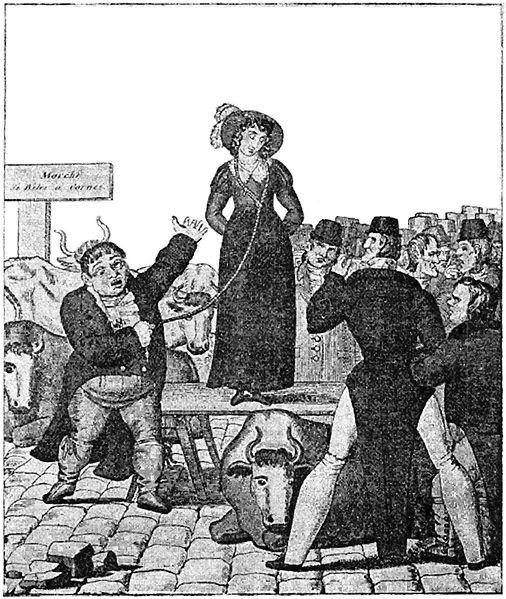Discontented Englishmen Used to Sell Their Wives at Auctions
At cattle markets, public houses and local landmarks in England in the 17th and 18th centuries, wives would be sold to the highest bidder.
In The Mayor of Casterbridge, Thomas Hardy wrote of a drunken Michael Henchard selling his wife, which led to disaster. Shocking though that is to modern thinking, at the time in England it was nothing out of the ordinary amongst the lower classes. There are nearly 400 verified cases of wives being sold, the earliest in London in 1553 when a master tailor sold his wife to a butcher. But cases were still being reported into the 1920s.

Bidding for women
The husband would take his wife to a market or fair where livestock was sold. The wife would have a halter around her neck or waist and would be displayed to potential buyers. And she would also have to agree to the sale. Far from the wife being unwillingly sold to a stranger, usually she knew the buyer, and the sale and the price had been agreed. Sometimes the wife arranged for her own sale. In a case in Plymouth in 1822 the wife even provided the money for her agent to buy her out of her marriage. Sometimes the wife was already living with her partner.
Divorce impossible
In the 1700s and 1800s divorce was prohibitively expensive, out of reach of all but the very rich. In his 1844 judgement against a bigamist, at Warwick Assizes, William Henry Maule described the process in detail. The bigamist should have, Maule told him, brought a legal action against the man who seduced his wife for criminal conversation. That would have cost about a hundred pounds. When he had obtained judgement in his favour for damages, he should have instructed his proctor to sue in the Ecclesiastical courts for a divorce a mensa et thoro. That would have cost up to three hundred pounds more.
After he had obtained that, his counsel should have appeared before the House of Lords to win a private Act of Parliament for a divorce a vinculo matrimonii. Then he would have been able to marry the person who he had married bigamously. However, the Bill could have been opposed in all stages in both Houses of Parliament. The bigamist would have had to spend up to twelve hundred pounds, a vast sum in those days, well beyond the reach of all but the very rich.
"Sitting here as an English Judge, said Maule, "it is my duty to tell you that this is not a country in which there is one law for the rich and one for the poor." He sentenced the man to imprisonment for one day. However, since the defendant had been in custody since the start of the Assizes he was free to leave.
Wife auctions advertised
This affirmation later contributed to the passing of the 1857 Matrimonial Causes Act of which allowed divorce courts to be set up, making it simpler to end a marriage, and considerably cheaper. But until then, divorce was out of the question for an unhappy couple, and it was a time when the wife was the property of the husband.
Wife sales were often advertised in newspapers and sometimes large crowds attended. It wasn't usually the case of a brutal husband getting rid of his wife. There were cases of the Poor Law Commissioners forcing husbands to sell their wives, rather than the commissioners having to maintain the whole family in the workhouse.
Wife sales solved problems
The idea behind the sales was to end an unhappy union, and give the end the legitimacy of a legal divorce. It could solve marital problems, such as the case of a woman who had married again believing that her sailor husband had drowned. When he reappeared the woman's new husband bought her from the first. It was legally binding if it was done properly, in front of witnesses. The halter and the bidding made it legal. The seller would get a receipt to forestall arguments about whether the sale had been made or not. Prices could range from as little as fourpence and a pint of beer to £50.
Escape from cruelty
The sale could be an escape for the wife. The Gentlemen's Magazine of 1832 reported one such case involving the Duke of Chandos. At a small country inn he saw a man cruelly beating his wife. He bought the woman for half a crown. She was young and good-looking. The Duke had her educated and, when her husband died, he married her. On her death bed she assembled the household, told them her story and explained that she had been raised from misery to a situation of great prosperity.
But the custom faded, with divorce becoming easier and women edging closer to equal rights with men. And the relatively simple method of parting was replaced by the divorce lawyer and custody battles.
Source:
Roud, Steve. The English Year. Penguin